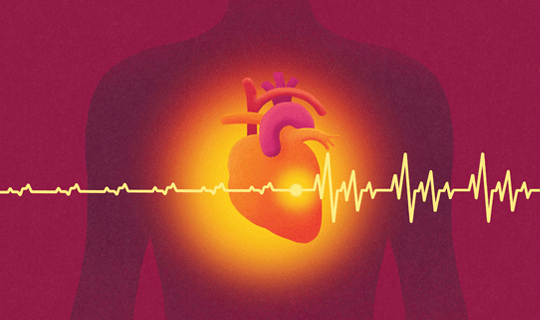
How advanced therapies for serious heart emergencies save lives.
Doctors call it cardiogenic shock—a condition that’s as serious as it sounds. “It’s often the result of an acute heart attack,” says Isaac Tawfik, MD, Chief of Cardiology and medical director of the cardiac catheterization lab at Monmouth Medical Center, and a member of RWJBarnabas Health Medical Group.

During a heart attack, a blockage in one or more coronary arteries obstructs blood flow to the heart. Circulation to the body may fail, heart cells may die—and the entire body may follow.
“In cardiogenic shock, the heart is not able to pump efficiently enough to meet the body’s demands, and organs fail for lack of oxygenation,” Dr. Tawfik says. “That’s an emergency. In addition to happening from a heart attack, it can occur as a result of having a severely leaky or narrowed heart valve or myocarditis [inflammation of the heart muscle] like the kind we’ve seen in association with COVID-19.” Cardiogenic shock carries a high mortality rate, Dr. Tawfik says: “It’s often a fatal condition.”
That’s why advanced lifesaving therapies to rescue people experiencing cardiogenic shock or other critical cardiovascular emergencies is a rapidly evolving area of innovation and a focus of investment for RWJBarnabas Health.
A Dramatic Improvement
At the heart of advanced lifesaving therapies are a category of technologies called mechanical circulatory assist devices, which help control blood flow. “Most of these are used in an intensive care phase of treatment when the heart is failing and too ill to pump enough blood on its own,” Dr. Tawfik says.
A classic and common example is a device known as an intra-aortic balloon pump, which is placed in the aorta, the major artery that delivers blood from the heart to the rest of the body. “Using an external module, the device inflates and deflates to help draw blood from the heart and pump it back into the body to places like the brain,” Dr. Tawfik says.
An intra-aortic pump can boost blood delivery by about half a liter per minute. “But even when treated with a balloon pump, patients with cardiogenic shock carry a close to 50 percent mortality,” Dr. Tawfik says. “There was a need for next-stage technologies in certain patients.”
In recent years, a new type of device has become available that boosts blood flow dramatically. The device features a small pump at the end of a flexible tube called a catheter. The catheter is threaded to the heart through an artery in the patient’s leg. Once in place, it pumps blood to the aorta from inside the heart. “This device provides between 2.5 and 5 liters of blood per minute instead of the half liter from a balloon pump,” Dr. Tawfik says. “That’s a lot more support.”
The improvement can amount to the difference between life and death. Dr. Tawfik recalls the case of a young woman who had a heart attack in which multiple arteries were blocked.
“Despite our best efforts to reopen them, her situation was rapidly deteriorating,” he says. “We installed this more advanced mechanical circulatory assist device, and she made it to the operating room and eventually made a full recovery. I don’t think she would have survived without this device.”
New Opportunities
Sophisticated devices like the one that saved the woman’s life can help patients survive so they can receive even more advanced care at specialized centers such as Robert Wood Johnson University Hospital (RWJUH) in New Brunswick. “It’s lifesaving to stabilize people in order to send them to a higher-acuity center,” Dr. Tawfik says. At centers such as RWJUH, even more advanced lifesaving therapies are available. These include ECMO (extracorporeal membrane oxygenation), which circulates oxygen rich blood and removes carbon dioxide using an external heart-lung machine. Another technology is LVAD (left ventricular assist device), which helps the heart’s main pumping chamber deliver blood to the body.
RWJUH can also provide critically ill patients with heart transplants. “But there are only a finite number of heart transplants done in the country,” Dr. Tawfik says. “The number of patients with cardiogenic shock and heart failure far outnumbers the organs available.”
As technologies improve, cardiologists have taken advantage of new opportunities for advanced care. “The whole field of heart failure is rapidly evolving,” Dr. Tawfik says. “There’s a push to help patients until they get an organ or receive destination therapy in which they may need devices for the rest of their lives.”
He points to how LVAD devices have changed. “When I was training 20 years ago, they were restricted to hospitalized patients because of their complexity and size,” he says. “Today, they’ve advanced and shrunk so much that patients can have them implanted in their chest with an external battery and take them home. People can continue to live their lives as best they can without being hospitalized with a device at their bedside.”
RWJBarnabas Health continues to invest in advanced lifesaving therapies both in terms of technologies and expertise. “We want to do everything we can to try and give people their best chance at life and health,” Dr. Tawfik says. “Our investments are a sign of the commitment we have to making sure patients get the best quality care possible.”
No one plans on heart disease, but everyone should have a plan for it. Connect with an RWJBarnabas Health heart and vascular specialist at 888-724-7123 or visit Heart and Vascular Care.
